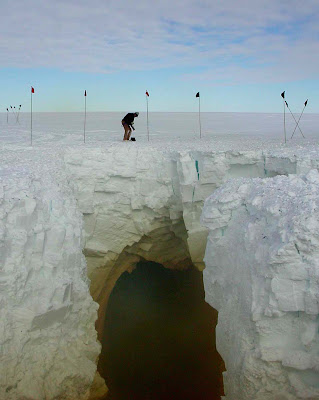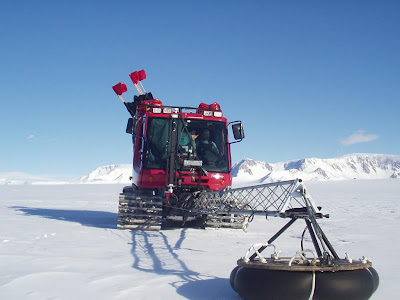We're going to Antarctica!
The long wait is over! We're dusting off the blog again several days before our deployment to the Antarctic ice sheet with the Yeti robot. I fly down on Wednesday in a long series of flights (Boston-> LA -> Auckland -> Christchurch -> Mcmurdo). I'll be posting here as regularly as possible, though it's likely that we'll be off the internets for a week while Jim and I are out on the ice. I've been told it'll be -40 for a good portion of the time, so I'll be updating this as much as I can in between times when my fingers are frozen solid.
For those of you who are new to the yeti robot project, in 2008, six undergraduate students from the Dartmouth Thayer School of Engineering designed and built the yeti robot, an autonomous ground vehicle designed to perform Ground Penetrating Radar (GPR) surveys of Arctic and Antarctic ice. Later that year, two of us took the robot out for its first trial by fire in Thule, Greenland. That experience was enough to convince me to stick around and do my M.S. at Thayer working on machine learning and improving the yeti robot's mobility in rough terrain. Now we have the opportunity to use Yeti to help the Antarctic Traverse team, and are deploying for the month of October to McMurdo.
The Yeti robot in Thule, Greenland.
The need for the Yeti robot crew out of a recently increase in scientific research in Greenland and at the South Pole, which has greatly increased the amount of food, fuel, and supplies that need to be delivered to these remote research bases. These were usually flown in using C-130 transport aircraft outfitted with skis, but this is both extremely expensive and environmentally unfriendly, and has the potential to impact the science efforts at the south pole by degrading air quality around the optical telescopes. Starting a few years ago, the Polar Programs office decided to reduce costs and impact by bringing the food and supplies overland using large tracked vehicles called snowcats.
The route between McMurdo and the South Pole is a little over 1600km long, most of which is boringly flat snow and ice. Certain areas, however, have large subsurface crevasses that are entirely invisible from the surface. These crevasses can be 1-10 meters wide and hundreds of meters deep, and only covered by several feet of snow and ice. Driving snowcats through these types of conditions can be extremely dangerous unless you know where the crevasses are. The traverse team currently uses a 30' boom on the front of the lead snowcat with a GPR antenna mounted on the front. This gives the driver a 2-second warning before the snowcat hits the crevasse.

The Antarctic Traverse team found this crevasse several years ago and blew it open with dynamite to get a better view.

A Pisten Bully snowcat outfitted with a radar boom on the front. This year, the Yeti robot will be used to supplement these, but hopefully will replace them in the future.
The Yeti robot was designed to address this (admittedly very specific) need for a better crevasse mapping capability. The goal of our current deployment is to collect the first ever autonomous GPR record in Antarctica and show that performing the surveys autonomously can improve speed and safety.
Thanks to everyone who've helped us get this far, especially Jim and the folks at CRREL and professor Laura Ray from Dartmouth for letting us borrow Yeti from her lab. Thanks also to my group members at PSI for helping me to work remotely for a month (It'll be a busy one!). More recently, thanks to the folks at Sparkfun for hooking us up with a GPS and some other components at the 11th hour!
Stay tuned for pictures, videos, and updates. I've been told that we're definitely not allowed to bring home a penguin, as this is protected by draconian international laws with harsh penalties and jail time.
I hope this will be a two-way communication, please feel free to ask lots of questions!

For those of you who are new to the yeti robot project, in 2008, six undergraduate students from the Dartmouth Thayer School of Engineering designed and built the yeti robot, an autonomous ground vehicle designed to perform Ground Penetrating Radar (GPR) surveys of Arctic and Antarctic ice. Later that year, two of us took the robot out for its first trial by fire in Thule, Greenland. That experience was enough to convince me to stick around and do my M.S. at Thayer working on machine learning and improving the yeti robot's mobility in rough terrain. Now we have the opportunity to use Yeti to help the Antarctic Traverse team, and are deploying for the month of October to McMurdo.
 |
The need for the Yeti robot crew out of a recently increase in scientific research in Greenland and at the South Pole, which has greatly increased the amount of food, fuel, and supplies that need to be delivered to these remote research bases. These were usually flown in using C-130 transport aircraft outfitted with skis, but this is both extremely expensive and environmentally unfriendly, and has the potential to impact the science efforts at the south pole by degrading air quality around the optical telescopes. Starting a few years ago, the Polar Programs office decided to reduce costs and impact by bringing the food and supplies overland using large tracked vehicles called snowcats.
The route between McMurdo and the South Pole is a little over 1600km long, most of which is boringly flat snow and ice. Certain areas, however, have large subsurface crevasses that are entirely invisible from the surface. These crevasses can be 1-10 meters wide and hundreds of meters deep, and only covered by several feet of snow and ice. Driving snowcats through these types of conditions can be extremely dangerous unless you know where the crevasses are. The traverse team currently uses a 30' boom on the front of the lead snowcat with a GPR antenna mounted on the front. This gives the driver a 2-second warning before the snowcat hits the crevasse.

The Antarctic Traverse team found this crevasse several years ago and blew it open with dynamite to get a better view.

A Pisten Bully snowcat outfitted with a radar boom on the front. This year, the Yeti robot will be used to supplement these, but hopefully will replace them in the future.
The Yeti robot was designed to address this (admittedly very specific) need for a better crevasse mapping capability. The goal of our current deployment is to collect the first ever autonomous GPR record in Antarctica and show that performing the surveys autonomously can improve speed and safety.
Thanks to everyone who've helped us get this far, especially Jim and the folks at CRREL and professor Laura Ray from Dartmouth for letting us borrow Yeti from her lab. Thanks also to my group members at PSI for helping me to work remotely for a month (It'll be a busy one!). More recently, thanks to the folks at Sparkfun for hooking us up with a GPS and some other components at the 11th hour!
Stay tuned for pictures, videos, and updates. I've been told that we're definitely not allowed to bring home a penguin, as this is protected by draconian international laws with harsh penalties and jail time.
I hope this will be a two-way communication, please feel free to ask lots of questions!

